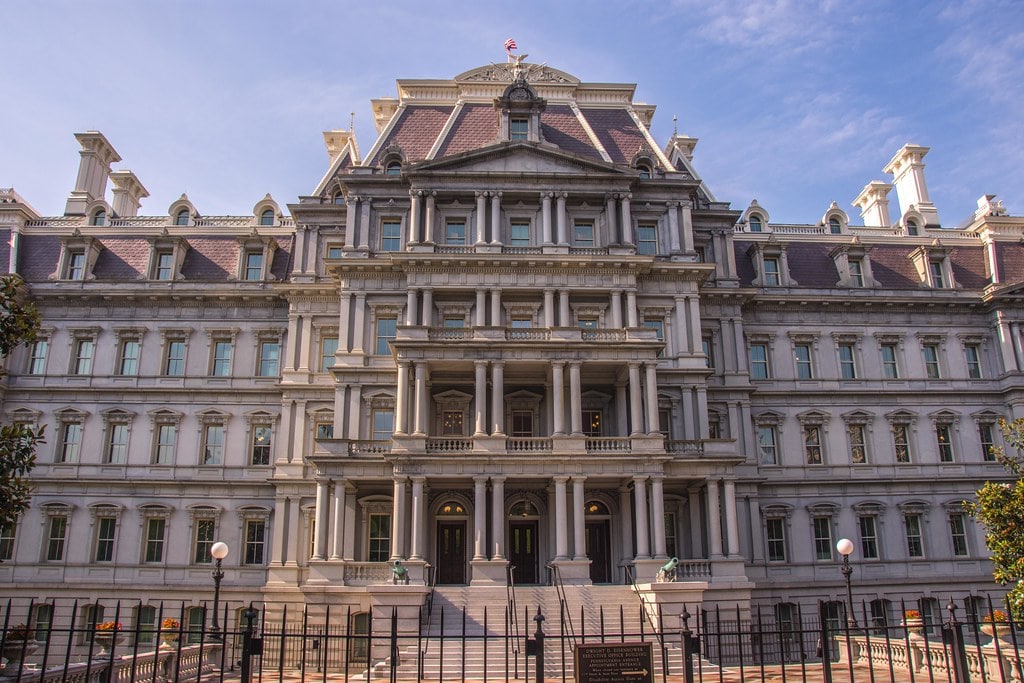How Trump Violated the Law to Pay the Military

Published by The Lawfare Institute
in Cooperation With

In mid-October, military personnel received their pay, just as they would have for any other pay period. The occasion, however, was notable for one reason: The federal government shutdown had left no usable money in the budget account to finance these payments.
How, then, were the troops paid?
The answer is troubling. To make these payments, President Trump used research and development (R&D) money that the Department of Defense had left over from last fiscal year—an action that was patently illegal.
In addition to being illegal, the move was also unnecessary. There is overwhelming support in Congress to enact legislation to pay the military. But instead of taking the legal, straightforward path to paying the troops (as in the 2013 Obama shutdown, when a law was enacted to pay the troops on the eve of the shutdown), the Trump administration opted for an illegal strategy because Speaker Mike Johnson (R-La.) had adjourned the House of Representatives on Sept. 19, sending its members home and refusing to reopen the House for business. (Note that no action was required to pay the military during either the 1995 Clinton shutdown or the 2018-2019 Trump shutdown because in each case the defense appropriations bill had already been enacted.)
Taken together with impoundments—where the president illegally chooses not to spend money he’s legally required to spend—the president is now violating spending law on both ends of the spectrum: He is not spending money he doesn’t want to spend while also spending money for unauthorized purposes. This has far-reaching—and potentially escalatory—implications.
The Illegality of the Move
The administration’s action to pay the military during the shutdown violates the Constitution, the Antideficiency Act (which gives teeth to the Constitution), and the “purpose” statute (31 U.S.C. § 1301), as well as appropriations law and authorization statutes.
Let’s start with the Constitution. Article I, Section 9, Clause 7, is often known as the Appropriations Clause. It says:
No Money shall be drawn from the Treasury, but in Consequence of Appropriations made by Law; and a regular Statement and Account of the Receipts and Expenditures of all public Money shall be published from time to time.
In plain terms, the federal government can’t spend money on something unless Congress has provided money for that specific purpose. The Antideficiency Act and the purpose statute are laws that enshrine this prohibition into the U.S. Code. Under the Antideficiency Act, the federal government can’t spend money without an appropriation enacted into law and an apportionment (explained below) of the appropriated funds by the president’s Office of Management and Budget (OMB). Under the purpose statute, it can’t spend the money it does have for any purpose not specifically allowed in the authorization law and the appropriation made for the budget account(s) that funds that authorized purpose.
When President Trump used money authorized only for the purpose of supporting R&D to instead pay the troops, he used existing money for a purpose not allowed by that appropriation. He also spent money to pay the troops when he didn’t have an appropriation usable for that purpose.
Pots of funding have periods of availability: time periods in which funding can be obligated—used—by the relevant agency. Think of a congressional appropriation as a credit card with an expiration date, but a special credit card that can be used only in certain stores. The credit limit is the amount of funding Congress appropriated. The period of availability determines the expiration date. The allowable purpose determines the stores at which you can use the credit card. Apportionment is when OMB activates the credit card.
A significant portion of programs receive new funding annually—like getting a new credit card. Most of that money is available for obligation for only a single fiscal year. Because fiscal year 2025 ended on Sept. 30 and Congress did not enact new appropriations bills for fiscal year 2026 or a continuing resolution to continue funding on a temporary basis, parts of the federal government are “shut down.” For those parts, there is no available credit card to swipe for certain activities—including military pay—because the old credit cards expired and Congress did not provide new ones. This is true even if the government never hit its credit limit and never obligated all of its funds. This is why there’s currently no money for military pay: That credit card expired on Oct. 1.
Why is there Department of Defense R&D money still available? In 2025, Congress provided over $140 billion to the research, development, test, and evaluation budget accounts to be obligated over two years—meaning the credit card for that money lasts through Sept. 30, 2026. There’s a lot of money still unobligated for this purpose. Congress regularly appropriates some money to be obligated over two or more years for certain budget accounts.
The payment of military salaries from unused R&D funds has been incorrectly described by the media, many members of Congress, and the administration as a “transfer.” However, a transfer is a specific budgetary action that moves money from one budget account to another budget account. Transfers cannot happen without explicit statutory language in funding bills allowing them. And while Congress does allow a very limited amount of general transfer authority in many annual funding bills, it imposes many constraints.
The Trump administration had originally indicated it would seek to transfer some of the unused R&D funds to the military personnel accounts, but that would have run up against one of the constraints for transferring money. Each year’s Defense Appropriations Act allows transfers only between two budget accounts funded within that same bill. In other words, only budget accounts that received their appropriation in the defense portion of the fiscal 2025 full-year continuing resolution can receive the money made available from the appropriation for R&D in that same continuing resolution. There’s also an $8 billion limit for total transfers within the Department of Defense under the funds appropriated in the fiscal year 2025 full-year continuing resolution. Finally, when the government transfers funds from one credit card to another, it must follow the rules and limitations of the budget account that receives the transfer.
The second of these conditions—the $8 billion limit—wouldn’t have been a problem for this set of paychecks but would have been a limiting factor for a second set of paychecks. The first and third conditions present a problem in tandem for a transfer this time. The R&D funding for fiscal years 2025-2026 and the military pay funding for fiscal year 2025 were both funded in the fiscal year 2025 defense appropriations bill, but there is no funding for 2026 military pay in that bill, meaning the R&D money couldn’t be transferred to a military pay account that was usable in fiscal year 2026 (which we are currently in). And if they’d instead tried to transfer the R&D money into the military pay account that ended in 2025, it would immediately take on the characteristics of rules and limitations of that budget account—one of those limitations being that those funds could be obligated only before Oct. 1, 2025.
So if the administration had wanted to transfer funds from the R&D credit cards to the military personnel credit cards, the money would have immediately become unusable because the military personnel credit cards expired on Oct. 1. Yes, the transfer would have successfully raised the credit limit, making room for additional swipes of the credit card. And yes, the money would be legally usable at one of the stores the credit card is allowed to make swipes from—in this case, for paying military personnel. But the swipes would still be declined because the credit card had expired.
So instead, the Trump administration swiped the R&D card—which hasn’t yet hit its credit limit and hasn’t yet expired—in a store that it’s not actually allowed to swipe in. Then they wrote a memo “justifying” the action.
The Perils of Antideficiency Act Violations
So, how bad is this? With respect to federal spending, I think there are five potential levels of egregiousness when violating the Antideficiency Act, depending on how willing the administration is to break laws. It’s important to understand that, once you’ve decided you’re not actually bound by the Constitution, the Antideficiency Act, or the purpose statute, any of these five levels is hypothetically available to you. The only limitations on your spending power are self-imposed.
In the narrowest, least egregious version of abuse—Level 1—think of an action that would have been legal a month ago. If in September the Trump administration had moved money from R&D accounts to military personnel accounts and then paid the troops their September salaries with that money, that would have been legal as long as the money moved didn’t put them over the $8 billion limit. (It would not have been necessary because there was sufficient funding for military personnel in fiscal year 2025, but at least it would have been legal.) But it’s not legal to use that money now, since the credit card has expired and Congress has not yet provided a fiscal year 2026 credit card to pay the troops.
However, based on the memo the Trump administration issued, the administration doesn’t indicate it feels constrained to what would have been legal a month ago and therefore does not feel limited to just the first level of badness. The memo doesn’t concede any size restrictions. It also does not indicate the administration feels this can happen only once, meaning it plausibly feels comfortable going above the $8 billion limit. While the administration didn’t actually transfer any funds this time, the memo indicates the administration plausibly doesn’t feel beholden to stick with what would have been legal a month ago.
Level 2 egregiousness would be something that sticks within a department or set of programs in a single funding bill, and still only uses money that Congress appropriated, and only for purposes that have been authorized. However, the administration illegally uses credit cards at the wrong store. This is what the White House did to illegally pay the military. While the administration’s memo explicitly references the purpose statute and pretends to abide by it, we don’t have to pretend to believe them.
At this level of badness, the administration would have diminished Congress’s role to merely setting all allowable actions an agency or department can take, as well as setting the total budget for the agency. But the administration would view any further program-by-program allocation Congress tried to make as optional. Congress passed a law providing $7.6 billion to feed hungry babies and pregnant women? Optional. Congress passed a law providing more than $45 billion for cancer, stroke, Alzheimer’s, and other cutting-edge biomedical research? Optional as well.
I’m positive this is not something that someone who supports this specific action by President Trump would actually want to be broadly available to their enemies. To imagine an extreme of a Level 2 violation, a future president could use this practice to shift funding passed by Congress on a bipartisan basis for border security and immigration enforcement and could take all the money Congress appropriates for Immigration and Customs Enforcement (ICE) and Customs and Border Protection (CBP) and instead use it on disaster relief efforts by the Federal Emergency Management Administration (FEMA). It would still only be money Congress had appropriated for the Department of Homeland Security, and it would still only be used on activities Congress had authorized.
Level 3 egregiousness would remove the limitation on remaining within the same part of the government. Instead of using money appropriated for ICE and CBP to pay for FEMA disaster relief as in the example above, imagine if a president defunded ICE and CBP and used all of its money for the refugee and entrant assistance program, a program housed outside of the Department of Homeland Security that helps international refugees, asylum-seekers, and victims of human trafficking gain employment and become self-sufficient in the United States.
Level 4 egregiousness—in my opinion, one that represents a significant escalation—would go beyond flexibly spending money from one budget account on purposes only allowed in another budget account. Instead, it would simply allow the president to spend more total dollars than Congress appropriated, giving him the ability to increase the credit limit of any credit card as much as he sees fit. In the previous three levels, the president was at least limited to budget authority that Congress approved, even if it was being taken from one purpose and one agency and illegally used for a different one. At this level, the president would be able to spend as much as he wants on whatever he wants, as long as it’s on an activity Congress has allowed.
I know of at least one instance—explained below—of the Trump administration willfully carrying out such an illegal Antideficiency Act violation this year. (That particular occasion was a little strange because Congress provided the money for that purpose—but in the act of carrying out a legal impoundment, the Trump administration also deleted some other money but then illegally chose to spend it anyway.)
What happened? In many funding bills, the Appropriations Committee designates some funding as an emergency under the Balanced Budget and Emergency Deficit Control Act as amended in order to place that budget authority outside of statutory funding limitations (or, more technically, to raise the limits by an equal amount). That funding exists outside the statutory caps if and only if the president also designates it as an emergency. Congress has chosen for decades to do this en bloc, rendering it an emergency if and only if the president chooses to designate all of it as an emergency—otherwise none of it is an emergency, and the budget authority is deleted (in order to prevent an accidental breach of the funding caps).
Nonetheless, for the accounts designated as an emergency pursuant to the Balanced Budget and Emergency Deficit Control Act as amended in the fiscal year 2025 full-year continuing resolution, President Trump chose to designate only some of the accounts as an emergency—thereby making none of it available. However, the agencies incurred obligations absent that budget authority, in strict violation of Section 1110(b) of the fiscal year 2025 full-year continuing resolution and the Antideficiency Act.
Next is what I believe to be the most egregious level of violation: Level 5. This would involve using money on an activity Congress expressly hasn’t allowed. That could be something like the president unilaterally giving everyone a $500 Department of Government Efficiency or tariff dividend, or implementing the Green New Deal without any authorizing legislation.
Once a president has decided that he is unbounded by the Constitution, the Antideficiency Act, or the purpose statute, any of these levels is possible. The only barriers left are self-imposed restrictions. You could argue the action to pay the military was Level 2 Antideficiency Act egregiousness (or Level 1 if you think the president does feel he couldn’t repeat this action for the next paycheck). President Trump has already carried out at least one Level 4 violation that would have been popular had it been reported on. It’s unclear whether he is deliberately testing the limits with popular violations in order to desensitize the public to broad violations and pave the way for frequent abuse.
If the president can ignore every part of authorization and appropriations law and simply fund whatever he likes and defund whatever he doesn’t like, that makes him the functional equivalent of an appropriations king.
In a set of talking points defending the action, the White House cited a handful of cases of previous presidents breaking the law. It should not need to be said, but while that might be helpful politically, it is not helpful legally. Just because a former president did something, it doesn’t make it legal. And if that president’s actions were never challenged in court, they are non-precedential.
Nonetheless, it should be noted that, of the past instances the White House contended were actions similar to President Trump’s move to pay the military during the shutdown, most of them happened before the Antideficiency Act was enacted. And in three of the four contended instances that did occur since its enactment, Congress explicitly ratified the action after the fact precisely because it did not feel the actions were allowed unilaterally. In the fourth case—President Kennedy’s creation of the Peace Corps—the Trump administration did not contend that Kennedy’s action was unlawful or inappropriate. And after Kennedy used funding on the Peace Corps, Congress chose to create a specific appropriation for it.
Far from being a legal defense of the president's directive, the talking points from OMB show that the president’s actions were unlawful by explicitly comparing them to other illegal actions. By couching the president’s actions as directly comparable to historical instances that required subsequent congressional ratification, it directly shows that today—and until Congress acts—the administration lacks the lawful authority to make these payments using these funds but is doing it anyway.
Potential Remedies
Even if this move has a few relevant historical precedents—at least, according to OMB—the direct assault on the rule of law is concerning and must be addressed by Congress, even if retrospectively. Whether this administration will face meaningful admonishment because of this constitutional and statutory violation is an open question. But the request to ratify its actions is another example to add to the ever-increasing list of provisions not currently included in the House-passed continuation—pending in the Senate—that must be addressed before the lapse can end in a coherent and orderly fashion.
It should also be noted that, while no one has ever been prosecuted for violating the Antideficiency Act, willful violation is a crime. And these recent violations are willful. Willful violation is a felony that carries up to 2 years in jail, up to a $5,000 fine, or both. That penalty was created in 1906 and hasn’t been substantively updated since. Had that fine grown with inflation, it would be roughly $185,000 for a single violation today. But keep in mind that the typical production worker had an hourly compensation of 16 cents, meaning a violation would cost the average person more than 15 years’ worth of compensation. A fine that large today would be more than $1.1 million. When Congress imposed those penalties, it clearly felt that willful Antideficiency Act violations were serious. The statute of limitations for an offense is five years. The statute of limitations for conspiracy to violate the Antideficiency Act is also five years.
What is to be done about this and other violations? The current Department of Justice is not likely to prosecute the Trump administration. But given the five-year statute of limitations—and this being only one of many violations over the past nine months, with more likely to follow—it is possible a future administration’s Department of Justice might choose to bring cases. However, it is also possible that President Trump could issue blanket pardons at some point during his presidency that would cover these illegal actions.
In the meantime, can the courts pursue action to stop or reverse illegality? It depends on which form of Antideficiency Act violations is being litigated. In this case, no transfer was involved. Had the administration chosen to transfer the funds, the transfer itself would have been legal but spending the transferred funds would have been illegal because the credit card had expired. However, if the White House began habitually employing illegal transfers as a first step to Antideficiency Act violations, there conceivably could be standing to stop or undo an illegal transfer by someone who was supposed to receive money from the account the funding was being drained from.
Similarly, if the president uses a credit card for a purpose not allowed, there may in some circumstances be standing from someone who should have benefited from a correct use of the credit card. Difficulties could arise if you’re someone who might have benefited. Someone who would have definitely benefited from these funds but now won’t benefit because there’s no money left would have standing.
But if the president wants to illegally spend money that has not been appropriated, regardless of whether the purpose is authorized or funded, it’s not clear that this particular Supreme Court would grant anyone with standing. The Court seems, after all, to have gone to considerable lengths to shield the Trump administration from legal consequences.
It should also be noted that these illegal budgetary actions are happening while Congress is busy trying to negotiate a budget. With the president asserting authority to completely ignore any budget agreement, Congress will have an especially difficult time coming to any budget agreement to begin with.
***
Across billions of dollars of impoundments, Antideficiency Act violations (including the largest in history), purpose statute violations, taking down the apportionment website (it is currently back online after a court case), and other actions, the Trump administration has seemingly undertaken the most illegal set of budgetary actions in history. Guardrails, new civil penalties, and expanded judicial standing are needed to restrain and penalize the White House’s budget malfeasance.




